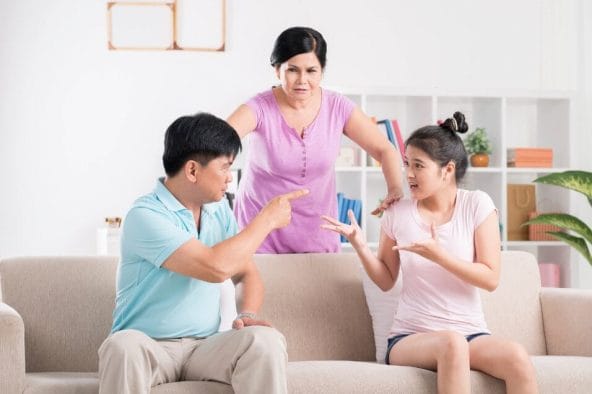
Healing from Emotional Incest: Rebuilding Your Sense of Self
- Published:
- Updated: April 28, 2025
When parents lean too heavily on their children for emotional support, something invisible but devastating happens: the child’s sense of self begins to fracture.
You might have spent years chasing approval, carrying unspoken guilt, or feeling like no matter what you did, it was never enough. Maybe you even learned to silence your own needs just to keep the peace.
If that sounds familiar, you may have experienced emotional incest — a hidden form of abuse that leaves no physical scars, but deeply wounds a child’s ability to trust, to feel safe, and to truly belong to themselves.
You’re not alone in this. And you’re not broken.
In this guide, we’ll explore what emotional incest really is, how it impacts your life, and how you can begin reclaiming the identity that was always meant to be yours.
Where we’re headed:
What emotional incest looks like (even in “normal” families)
How it fractures your identity and relationships
Practical steps to rebuild boundaries, trust, and self-worth
Healing takes time. Feel free to revisit this guide as many times as you need—there’s no rush. Each step you take, no matter how small, is part of your reclaiming journey.
What's Inside This Healing Guide:
What is Emotional Incest?
Emotional incest happens when a parent crosses invisible lines—leaning on their child for emotional comfort, support, or even companionship in ways a child is never meant to bear.

It’s not physical abuse. It’s not sexual abuse. But make no mistake: it’s still a profound betrayal of boundaries.
When this dynamic takes hold, a child is no longer allowed to simply be a child. Instead, they’re pulled into the adult world far too soon—forced to carry emotional burdens that don’t belong to them.
Over time, emotional incest fractures a child’s ability to trust, to express needs without shame, and to feel safe in relationships.
It quietly teaches them that love means obligation—and that their own needs don’t matter.
If you’d like to hear more about how emotional incest impacts us—personally and professionally—I shared deeper reflections on The SVee Show Podcast.
(Click the link if you want to listen after reading.)
Next, we’ll explore how emotional incest plays out among different family members—and the lasting impact it leaves across generations.
How Emotional Incest Damages the Whole Family
Emotional incest doesn’t just wound the child caught in the crossfire.
It distorts the emotional health of the entire family.
Parents who lean too heavily on their children lose touch with healthy adult boundaries.
Siblings become competitors for approval—or silent witnesses to pain they don’t know how to name.
And the child at the center often grows up believing they are responsible for everyone’s happiness—and guilty for everyone’s failures.
The cost isn’t just personal. It’s relational. It’s systemic.
In my coaching work, I’ve seen how these patterns echo across generations—sometimes quietly, sometimes explosively—until someone finally stops to name the truth and break the cycle.
Let’s look at how this pain shows up in real life.

Sally: When Caretaking Becomes a Life Script
Sally (name changed) grew up in a home overshadowed by her mother’s alcoholism.
As a young girl, she believed every unpaid bill, every financial crisis, was somehow her fault.
She took on after-school jobs, scraped together what she could—but no matter how much she gave, her mother’s chaos only deepened.
That early script—the belief that love meant rescuing others—followed her into adulthood.
In her marriage, she found herself once again holding the emotional and financial weight alone.
Her ex-husband’s addictions quietly drained her retirement savings while she tried to “hold the family together” at any cost.
It wasn’t until an accountant showed her the truth on paper—the mounting debts, the disappearing funds—that Sally realized: caretaking had come with an unbearable price.
Rachel: When Secrets Become Emotional Shackles
Rachel (name changed) grew up carrying secrets far too heavy for a child.
Night after night, her mother would sit her down—tearfully confiding in her about her father’s betrayals, affairs, and broken promises.
Rachel became her mother’s confidant, counselor, and emotional caretaker—all before she was old enough to even understand what marriage truly meant.
Instead of feeling safe in her family, Rachel learned that love came with heavy emotional debts—and that her needs would always come second to someone else’s pain.
What Causes Emotional Incest?

In emotional incest, a parent seeks emotional support, companionship, and validation from their child. The parent might depend on the child to meet their emotional needs, treating them as a confidant, surrogate partner, or source of intimacy.
This form of incest occurs when a parent is emotionally unavailable or lacks appropriate adult relationships, leading to an inappropriate reliance on their child to fill the void.
I grew up under the influence of two emotionally disabled individuals. My mother sought solace in me, both physically and sexually, while my father relied on me for mental support. This overwhelming combination had a profound impact on my perception of love and relationships.
Still wondering if you were a victim of emotional incest? Below are some signs that you were abused during your childhood.
Signs of Emotional Incest
Emotional incest often leaves no visible scars—but it shapes how we see ourselves, how we love, and how we relate to others.
Here are some of the most common signs that emotional boundaries were crossed—and how they show up in real life.

1. Role Reversal: When the Child Becomes the Caregiver
Instead of offering guidance and protection, the parent leans on the child for emotional support, advice, or companionship.
The child becomes a confidant or a surrogate partner—expected to carry emotional burdens far too heavy for their age.
Example: Rachel’s Story
Rachel (name changed) grew up carrying secrets no child should ever have to hold.
Night after night, her mother confided in her about her father’s betrayals, affairs, and broken promises.
Rachel became her mother’s emotional caretaker long before she even understood what marriage meant.
In the process, she learned that love meant absorbing someone else’s pain—and burying her own needs deep inside.
2. Emotional Enmeshment: When Boundaries Disappear
In emotionally enmeshed families, the child’s sense of identity becomes fused with the parent’s emotions.
The child feels responsible for the parent’s moods, happiness, and well-being—losing the ability to differentiate their own needs from those around them.
Example: David’s Story
David (name changed) learned early that laughter could calm the storms at home.
Whenever his older brother’s anger shook the household, David would crack jokes to defuse the tension, believing it was his job to keep the peace.
As an adult, he struggled with deep sadness—feelings he had learned to bury under smiles and jokes.
Behind that sadness lived an even heavier weight: shame for having needs he was taught never to express.
If you grew up surrounded by secrets, emotional chaos, or unspoken expectations, it’s no surprise you might carry feelings of guilt or shame today.
You were handed emotional burdens you were never meant to carry—and healing starts by recognizing that none of it was your fault.
When you have grown up in a family where there is secrecy, lies and abuse, feeling SHAMEFUL about yourself is normal.
— Denise G. Lee (@DeniseGLee) July 9, 2024
And shame isn't the same as guilt.
Guilt = Wanting to repair wrongs for what has been done.
Shame = Feeling wrong for who you are.
Your parents or whoever…
3. Emotional Neglect: When a Child’s Needs Are Silenced
In homes marked by emotional incest, the parent’s needs dominate the emotional landscape.
The child quickly learns that their own feelings—sadness, anger, fear, even joy—are unwelcome interruptions.
Over time, children in these environments internalize a painful lesson:
My needs don’t matter. My job is to make others comfortable, even at my own expense.
As adults, this often shows up in heartbreaking ways:
Becoming relentless workaholics, believing achievement is the only path to acceptance.
Ignoring physical and emotional pain until it explodes into illness or burnout.
Feeling guilty for resting, asking for help, or needing emotional support.
In trying to survive the emotional demands of childhood, many learn to silence themselves so completely that they struggle to even recognize their own needs later in life.
Healing begins by honoring what was silenced—and by learning, often for the first time, that your needs are not a burden. They are a birthright.

4. Boundary Erosion: When a Child’s World Stops Feeling Safe
Healthy families teach children where they end and others begin.
They model respect for privacy, emotions, and personal space.
But in families marked by emotional incest, those natural boundaries are blurred—or shattered entirely.
The parent may:
Invade the child’s physical or emotional space without permission.
Demand loyalty or emotional caretaking that leaves no room for the child’s own needs.
Treat the child as an extension of themselves, rather than as a unique, separate being.
Without safe boundaries, a child grows up confused about where they end and others begin.
They may struggle to form healthy romantic relationships, trust their instincts, or even recognize emotional violations until long after they’ve been harmed.
The effects don’t fade easily.
Many survivors of emotional incest carry deep struggles with intimacy, self-trust, and guilt—haunted by a childhood where love was entangled with obligation and emotional exposure.
How to Claim Your Healed and Healthy Life
Emotional incest leaves scars you can’t see, but deeply feel.
It teaches children to bury their needs, question their instincts, and tie their worth to how well they take care of others.
Left unhealed, those wounds can echo for decades—showing up as struggles with intimacy, trust, boundaries, and self-worth.
But here’s the truth:
You are not broken. And you are not beyond repair.
The patterns you learned were about survival, not about who you truly are.
Healing is possible—and it begins by gently reclaiming what was taken: your right to feel safe, to have needs, and to belong fully to yourself.
Let’s walk through how to begin.

Step 1: Recognize That It Happened
Healing begins with the hardest truth of all:
Admitting that it happened.
Not minimizing it.
Not rationalizing it.
And definitely not telling yourself, “It wasn’t that bad.”
Emotional incest doesn’t always leave obvious scars—but it reshapes how you see yourself, how you trust, and how you love.
And if you grew up carrying more than your heart was meant to hold, that wound deserves to be honored—not hidden.
It’s common to bury the pain under busyness, achievement, addictions, or perfectionism. Survival demanded it once.
But now, your healing asks for something different:
the courage to see your story clearly.
Recognizing what happened isn’t about blaming. It’s about naming.
It’s the first step toward reclaiming your voice, your worth, and your right to live fully in your own skin.
Step 2: Create Boundaries That Honor You
When you grow up carrying your family’s emotional burdens,
saying no can feel like betrayal.
You were trained to soothe, fix, and sacrifice—even when it cost you everything.
As an adult, that training doesn’t just vanish.
It often shows up in subtle, exhausting ways:
Relatives showing up uninvited with endless complaints.
Conversations that drain you, leaving you tense and hollow.
Expectations that you’ll keep rescuing them—emotionally, financially, or otherwise.
No wonder you feel stretched thin.
No wonder your body and spirit are tired.
You are not here to be everyone’s emotional safety net.
Setting boundaries isn’t cruelty. It’s survival.
It’s how you teach others—and yourself—that your time, energy, and peace matter.
You don’t have to save them.
Yes, you don’t have to carry what was never yours.
Now you are allowed to protect your heart without guilt or shame.
Step 3: Reclaim Your Body, Rebuild Your Trust
When emotional incest steals your childhood, it doesn’t just shape your heart.
It teaches you to abandon your own body.
You learn to override your hunger, your tiredness, your sadness—because tending to yourself was never the priority.

As adults, that survival script often lingers:
Working until exhaustion becomes normal.
Using sugar, screens, relationships, or addictions to dull the ache.
Swinging between neglect and obsession with food, exercise, or sleep.
But here’s the truth your body has been waiting to hear:
You are allowed to care for yourself—not as a reward, but as a right.
Self-care isn’t just about routines.
It’s about rebuilding trust with yourself—one small act at a time.
Some simple ways to begin:
Move with kindness: Walk, stretch, dance—not to punish yourself, but to reconnect with feeling alive.
Breathe with awareness: A few minutes of stillness each day reminds your nervous system that it’s safe to exist.
Touch the earth: Time in nature gently rewires your body’s sense of grounding and belonging.
Every small act of care says: I matter.
Every moment you honor your needs says: I’m home now.
Step 4: Reclaim the Self They Tried to Rewrite
When emotional incest takes root, it doesn’t just burden a child with grown-up responsibilities.
It steals the right to fully know yourself.
Your identity becomes entangled in other people’s moods, needs, and expectations.
You learn to shape-shift: being whoever you need to be to keep the peace.

It’s no wonder that claiming your identity now might feel terrifying.
Because for so long, being yourself wasn’t safe—it was dangerous.
But here’s the truth:
You are not here to be someone else’s emotional shelter. You are here to become fully, fiercely you.
Reclaiming your identity starts gently—by listening to the parts of yourself that were silenced.
Some ways to reconnect:
Play: Paint, write, dance, build, explore—not for anyone else’s approval, but for your own joy.
Curiosity: Ask yourself what you love—not what others expect from you.
Permission: Allow yourself to change. To not know. To become.
You are not frozen in who you had to be.
You get to become who you were always meant to be.
Step 5: Build Relationships That Honor Your True Self
Healing doesn’t happen in isolation.
But when you’ve been trained to shape-shift for love, learning to build real, healthy relationships can feel terrifying.

It’s normal to hesitate.
It’s normal to wonder if it’s safer to stay distant.
Because for a long time, love meant obligation. Trust meant betrayal. Connection meant cost.
But the truth is this:
You deserve relationships where your boundaries are honored, your voice is welcomed, and your needs are not a burden.
Building these relationships starts slowly:
Listen to your body: If someone’s presence feels exhausting, confusing, or unsafe, trust that.
Notice reciprocity: True connection isn’t built on you always giving and them always taking.
Practice discernment, not judgment: It’s okay to take time to know who is safe enough to trust.
You don’t have to open your whole heart overnight.
Yes, you don’t have to trust everyone.
You just need to begin gathering people who meet you where you are—with patience, respect, and care.
Healing doesn’t mean being fearless.
It means being willing to trust again, one small, courageous step at a time.
Step 6: Practice Self-Compassion First—and Redefine Forgiveness
Healing from emotional incest isn’t about erasing the past.
It’s about releasing the power it still holds over your present.

That process starts with radical self-compassion:
Acknowledging that none of this was your fault.
Honoring the survival strategies you once needed.
Giving yourself permission to heal in imperfect, non-linear ways.
Forgiveness—if and when it comes—is not about condoning what happened.
It’s not about denying the hurt.
And it’s definitely not about re-opening yourself to unsafe people.
Forgiveness is about freeing yourself.
It’s about loosening the emotional grip that pain, anger, or resentment may still have on your nervous system, your heart, your joy.
You don’t owe your abuser reconciliation.
You owe yourself peace.
Forgiveness, if you choose it, can be a private act—done without apology, without permission, without performance.
It can simply be the quiet moment when you say, “You no longer get to live rent-free in my body, my mind, or my future.”
And always, always:
Start with compassion for yourself.
That’s where real freedom begins.
Healing from emotional incest isn’t about becoming someone new.
It’s about becoming someone whole.

Frequently Asked Questions
If you're still processing what emotional incest means—or how to begin healing—these questions may offer some clarity and reassurance.
Is emotional incest the same as sexual abuse?
No. Emotional incest doesn’t involve physical or sexual contact—but it does involve a parent crossing emotional boundaries, often treating the child as a surrogate partner, therapist, or confidant.
How do I know if I experienced emotional incest?
If you were expected to take on adult emotional responsibilities as a child—comforting your parent, keeping secrets, or being their main source of support—you may have been a victim.
Can I heal without confronting my parent?
Yes. Healing doesn’t require confrontation. It begins with validating your experience, setting boundaries, and reclaiming the parts of you that were never allowed to exist freely.
Why does this still affect me as an adult?
Because emotional incest disrupts the foundation of self-trust and belonging. Those patterns often echo through adulthood until they’re consciously addressed and healed.
What are some first steps to begin healing?
Recognize what happened, name the pattern, and start setting boundaries that honor your emotional space. Therapy or coaching can help—but even gentle, private journaling can
Final Reflections: Honoring Your Healing Journey
Healing from emotional incest is not a straight line.
It’s a winding, tender, sometimes painful path—full of moments where you question, grieve, celebrate, and begin again.
If you find yourself feeling overwhelmed, stuck, or unsure along the way, that doesn’t mean you’re failing.
It means you’re doing the real, messy, courageous work of becoming whole.
Read this carefully and slowly. You are allowed to:
- Take your time.
- Rest.
- Ask for help.
Sometimes that help will come from trusted friends, communities, or skilled professionals who understand the deep roots of this kind of pain.
Sometimes it will come from the quiet, persistent voice inside you that says, “Keep going. You’re worth saving.”
You don’t have to heal perfectly.
You just have to keep choosing yourself—over and over again.
And that choice alone is a revolution.
If this resonated with you—
If you recognize pieces of your own story here—
Know that you don’t have to untangle it all alone.
When you’re ready, I’m here to support your healing journey with honesty, tenderness, and practical tools.
You deserve a future that feels safe inside your own skin.





